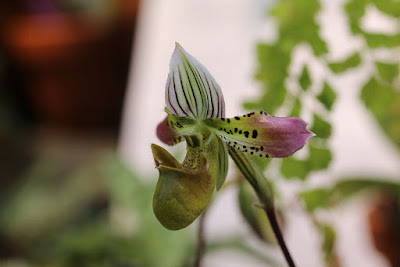Paphiopedilum acmodontum is endemic to Negros Island in the Visayas sea area of the Philippines and found at elevation between 1000 and 1500 m above sea level. It grows as a terrestrial herb, in subtropical or tropical moist montane forest...
Paphiopedilum acmodontum also called as The Pointed Tooth Paphiopedilum, is a species of the genus Paphiopedilum. This species was described by Mark W. Wood in 1976.
IDENTIFY PAPHIOPEDILUM ACMODONTUM
Paphiopedilum acmodontum is endemic to Negros Island in the Visayas sea area of the Philippines and found at elevation between 1000 and 1500 m above sea level. It grows as a terrestrial herb, in subtropical or tropical moist montane forest.
It is a medium-sized, hot to warm growing terrestrial with up to 18 cm long, 4 cm wide, distichous, elliptic-oblong, acuminate, minutely tridentate apically leaves that are tessellated light and dark green.
The Pointed Tooth Paphiopedilum blooms on an erect, single flowered, to 25 cm long, sparsely pubescent, green and purple splashed inflorescence with ovate, pubescent floral bracts. The flowers are 7 cm in diameter. The dorsal sepal is ovate, acute, white or pinkish, lined with dark purple or purple-green veins. The synsepal is ovate, acute, white, tinged purple with purple and green veins. The petals are spreading-reflexed, ligulate-oblanceolate, tridentate at apex, sparsely ciliate and pubescent at base, green below, purple above, veined with and spotted dark purple in basal half. The lip is deeply saccate, prominently auriculate, dentate or apiculate at apex, minutely pubescent, ciliate, bronze or olive-green with darker veins. Staminode is obovate, minutely pubescent, distal margin 3-toothed, midtooth longer than the two lateral, pale green tinged with bronze or green.
PAPHIOPEDILUM ACMODONTUM CARE AND CULTURE
Cultural information should only be used as a guide, and should be to be adapted to suit you. Your physical location; where you grow your plants, how much time you have to devote to their care, and many other factors, will need to be taken into account. Only then can you decide on the cultural methods that best suit you and your plants.
Light:
Paphiopedilum acmodontum needs a light level of 10000-15000 lux. The leaves should be a medium-green color, if they are too pale or yellowish, the plant could be getting too much light.
Temperature:
Coming from hot and humid climates, this species does not tolerate low temperatures, so its cultivation should be done in environments whose minimum temperatures do not fall below 14 ° C and can, for periods not very prolonged of time, tolerate temperatures slightly lower (12 ° C). The daytime temperatures is between 18 and 28 ° C during the day and a night setback to 15 ° C. In the winter months they can to be kept a little cooler.
Humidity:
The Pointed Tooth Paphiopedilum prefer a high humidity, but requires sufficient air circulation and fresh air.
Substrate, growing media and repotting:
Paphiopedilum acmodontum recommended a substrate which composed of a mixture of medium pine bark, expanded clay and perlite. These plants are particularly sensitive to degraded soil around the roots, so they should be repotted immediately when the substrate begins to decompose. It's best to do it, when new roots start growing. Then the plant is able to root and stabilize as soon as possible.
Watering:
The cultivated plants should be abundantly watered during active growth, but excellent drainage should be ensured, and the roots must dry quite quickly after watering. In late autumn, when the new increments reach maturity, the amount of water should be reduced.
Fertilizer:
This plant needs to weekly feed 1/10-1/4 of the recommended dose of fertilizer for orchids. In the period of active growth, a fertilizer with a high nitrogen content should be used, and in the middle of summer switch to a fertilizer with high phosphorus content to improve flowering and strengthen young growths before winter.
Rest period:
In winter, watering for Paphiopedilum acmodontum somewhat can be limited, but they must not be allowed to stay dry for a long time. Fertilization should be reduced until more intense watering starts in the spring.

















COMMENTS